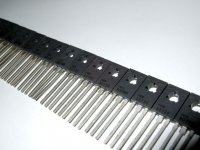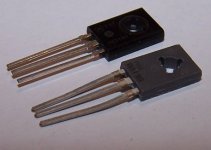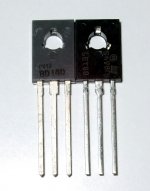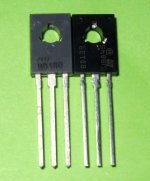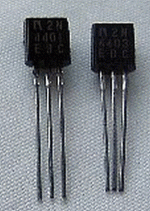I did not say degrade. I said Dgrade, The extra letter code shown in your pic.
Dgrade is 60 to 120hFE at test current of 50mA.
OK got it.
And one that nobody here had considered yet is R(th)C-S. Yep, case to sink.
Ah, but Rcs is defined as dT/dW, average dW and average dT.
If the device sink is 0.6mm thick and 1cm wide, copper, heat will travel 1cm at a pace of ~0.24 W/k.
Thinner means worse heat distribution, means higher Rcs, even when perfectly flat.
Dang, 70ma average, rendered me speechless.
Found a last forgotten batch in the drawer Philips looking bugs in a small store. ST and ON is what I mainly see in stores. They measure circa 150 hFE very tightly between NPN-PNP, all of them. The ST I also got some to measure had 210NPN-110PNP on average. The BD139s have something illegible like PH3B or PHBn when the BD140s have PH12. Are those the small die high Ft proper Philips ones?
Attachments
Found a last forgotten batch in the drawer Philips looking bugs in a small store. ST and ON is what I mainly see in stores. They measure circa 150 hFE very tightly between NPN-PNP, all of them. The ST I also got some to measure had 210NPN-110PNP on average. The BD139s have something illegible like PH3B or PHBn when the BD140s have PH12. Are those the small die high Ft proper Philips ones?
If the plastic is grey (the ones in the photo seem to be), they might be genuine Philips transistors.
BUT... one of our customers uses BD139/BD140 in some designs. The BOM says we must use ON and "do not use Philips". I don't know the reason for that, but I can't imagine counterfeiters are interested in copying something this cheap.
EDIT: About 12 years ago I built a class A headphone amp which uses BD139/BD140 in the "power" amp. One of the two types were Philips and looked very similar to your's.
Last edited:
the small die high Ft proper Philips ones?
Crooked printing :yes.
I'm not sure i get the question.
Philips splitted off the semi-divison 4 years ago, sold 5/6th of the shares to a couple of private equity clubs.(two months ago, Phily dumped the remaining 1/6th share)
NXP still uses the BD139/140 dies for other packaged products, same animals, same quality.
Not sure whether NXP will have as deep as pockets for future development as Phily had.
Philips splitted off the semi-divison 4 years ago, sold 5/6th of the shares to a couple of private equity clubs.(two months ago, Phily dumped the remaining 1/6th share)
NXP still uses the BD139/140 dies for other packaged products, same animals, same quality.
Not sure whether NXP will have as deep as pockets for future development as Phily had.
I'm not sure i get the question.
Philips splitted off the semi-divison 4 years ago, sold 5/6th of the shares to a couple of private equity clubs.(two months ago, Phily dumped the remaining 1/6th share)
NXP still uses the BD139/140 dies for other packaged products, same animals, same quality.
Not sure whether NXP will have as deep as pockets for future development as Phily had.
You understood exactly. I wanted to know if NXP classic Philips transistors are same spec. Thanks! Great to have a Jacco partner! To paraphrase a missing legend's song rendition. Since I know you like his later (and late also) band.
Yeah, great, songs as that will still turn me 20s in my 80s.
(for some reason, most of my favs die early by heart failure)
The originals and offspring were already parlee'd, see mr Alex's Nikitin's comment here : http://www.diyaudio.com/forums/part...yone-use-these-transistors-2.html#post1144750
(for some reason, most of my favs die early by heart failure)
The originals and offspring were already parlee'd, see mr Alex's Nikitin's comment here : http://www.diyaudio.com/forums/part...yone-use-these-transistors-2.html#post1144750
Not much point in shopping Phi TO126, if NXP still makes them.
Several Japanese parts are superior, but much more expensive or just as hard to get by nowadays.
I've got about a thou of the 139/140 in 10-16 dress, nice generic part to have plenty in stock, built up to 10-pair Class A output stages with them, the 3.2 Rjc becomes a relative number with plenty in parallel.
Several Japanese parts are superior, but much more expensive or just as hard to get by nowadays.
I've got about a thou of the 139/140 in 10-16 dress, nice generic part to have plenty in stock, built up to 10-pair Class A output stages with them, the 3.2 Rjc becomes a relative number with plenty in parallel.
BD139 will soon cost a great deal
The transistor is too good, for its own good.
I use it in my QRP transmitters for 20 meters and 15 meters. With an Ft of 160Mhz @ 1amp, it is ideal for a PA.
Heat sinking the transistor, you can get 3 watts out of it. Paralleling it with 4 units will give you 16 watts when heat sink. Which is outstanding for QRP work.
But there are better transistors out there. Oh yes, the BD139, is a copy of the Motorola's 2N4900 series. Not exact copy, but real close.
One of the biggest problems that most of us will have in the future, is that a great deal of the Japanese designs will disappear from the market as we move deeper into SMD.
That is because the Chinese are buying up stock piles faster than anyone else can get a bid in on the products. Soon we will be buying 95% of all of our components from China, due to the fact that they have all of the market credit to do so. So if you are not hording, you best start today.
Take Care
Ivey
The transistor is too good, for its own good.
I use it in my QRP transmitters for 20 meters and 15 meters. With an Ft of 160Mhz @ 1amp, it is ideal for a PA.
Heat sinking the transistor, you can get 3 watts out of it. Paralleling it with 4 units will give you 16 watts when heat sink. Which is outstanding for QRP work.
But there are better transistors out there. Oh yes, the BD139, is a copy of the Motorola's 2N4900 series. Not exact copy, but real close.
One of the biggest problems that most of us will have in the future, is that a great deal of the Japanese designs will disappear from the market as we move deeper into SMD.
That is because the Chinese are buying up stock piles faster than anyone else can get a bid in on the products. Soon we will be buying 95% of all of our components from China, due to the fact that they have all of the market credit to do so. So if you are not hording, you best start today.
Take Care
Ivey
Crooked printing :yes.
Printing might be straight on a good day...
When building the headphone amp I bought a few extra, just in case, I found them stashed away somwhere.
Probably another thing to recognize the Philips' genuineness by is that the leads seem made from a softer metal (more copper?) than most others. These are quite easy to bend. They are slightly wider too which is hard to see in the picture, but if you lay the Motorola on top of the Philips, you'll see that the Philips' leads are ca. 1 1/3 the width of the Motorola.
Attachments
- Home
- Design & Build
- Parts
- My Transistors, original or copy?
